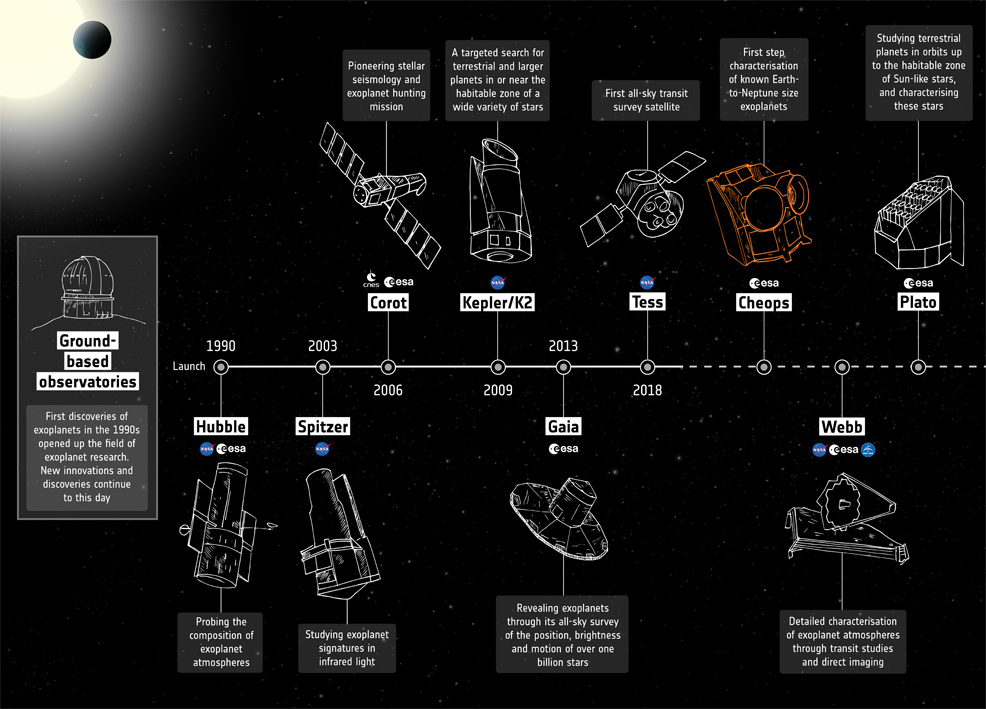
18th December 2019 CHEOPS: Exoplanet mission blasts off The CHEOPS space telescope, whose mission is to study the formation of extrasolar planets and determine their precise radius, likely density and internal structure, was successfully launched today.
CHaracterising ExOPlanets Satellite (CHEOPS) – a joint mission of the Swiss Space Office (SSO) and European Space Agency (ESA) – lifted off this morning at 08:54 GMT from Kourou, French Guiana. Signals from the spacecraft, received at the mission control centre in Madrid, Spain, at 11:43 GMT, confirmed that the launch was successful. ESA's first mission dedicated solely to extrasolar planets, it will investigate bodies already known and previously discovered beyond our Solar System and provide new insights into the nature of these distant, alien worlds. Scientists had long speculated about the existence of exoplanets until the discovery of 51 Pegasi b, the first planet found around a Sun-like star, which was announced in 1995. The discoverers, Didier Queloz and Michel Mayor, recently shared the 2019 Nobel Prize in Physics for their historic finding, which marked the beginning of a new era in space research, and has become one of the fastest growing areas of astronomy. In the 25 years since 51 Pegasi b was revealed, astronomers using telescopes on Earth and in space have discovered more than 4,000 exoplanets around stars near and far, most of which have no counterparts in our Solar System. This widely diverse assortment ranges from gassy worlds larger than Jupiter to smaller, rocky planets covered in lava, with the most abundant exoplanet type found in the size range between Earth and Neptune. "CHEOPS will take exoplanet science to a whole new level," said Günther Hasinger, ESA Director of Science. "After the discovery of thousands of planets, the quest can now turn to characterisation – investigating the physical and chemical properties of many exoplanets, and really getting to know what they are made of and how they formed. CHEOPS will also pave the way for future exoplanet missions, from the international James Webb Telescope to ESA's very own Plato satellite."
CHEOPS will not focus on the search for new planets. Instead, it will follow-up on hundreds of known planets that have been discovered through other methods. The mission will observe these planets exactly as they transit in front of their parent star and block a fraction of its light, to measure their sizes with unprecedented precision and accuracy. These measurements of exoplanet sizes will be combined with existing information on their masses to derive the planet density. This is a key quantity to calculate the internal structure and composition of planets and determine whether they are gaseous like Jupiter or rocky like Earth, whether they are enshrouded in an atmosphere or covered in oceans. CHEOPS will provide at least 1.2 gigabits/day of data downlink capacity and its mission duration is forecast to be 3.5 years. For some planets, CHEOPS may reveal details about their atmosphere, such as the presence of clouds and even hints of the cloud composition. The mission also has the capability to discover previously unknown planets by measuring tiny variations in the timing of the transit of a known planet, and could also be used to search for moons or rings around some worlds. "There are so many interesting exoplanets and we will be following up on several hundred of them – focusing in particular on the smaller planets in the size range between Earth and Neptune," says Kate Isaak, ESA CHEOPS project scientist. "They seem to be the commonly found planets in our Milky Way galaxy, yet we do not know much about them. CHEOPS will help us reveal the mysteries of these fascinating worlds, and take us a step closer to answering one of the most profound questions we humans ponder: are we alone in the Universe?"
Comments »
If you enjoyed this article, please consider sharing it:
|







